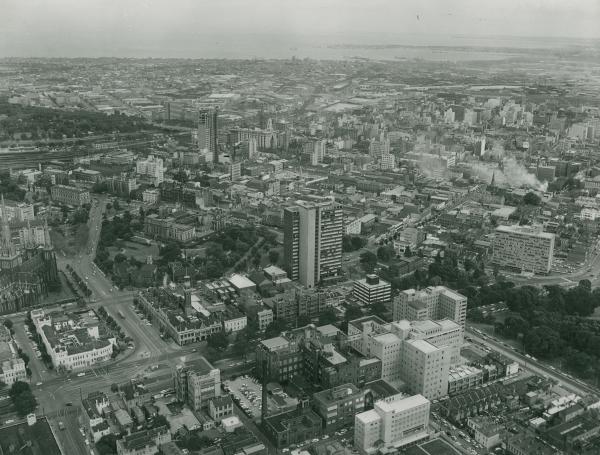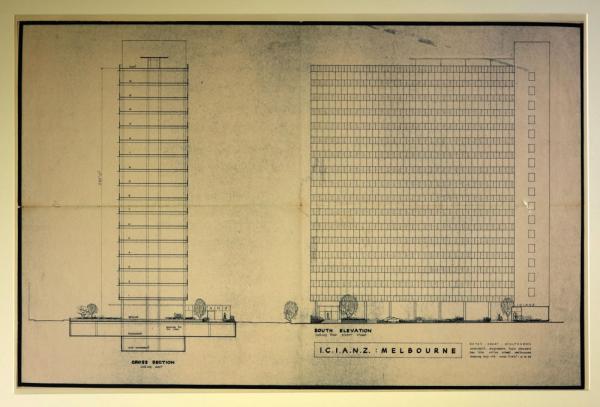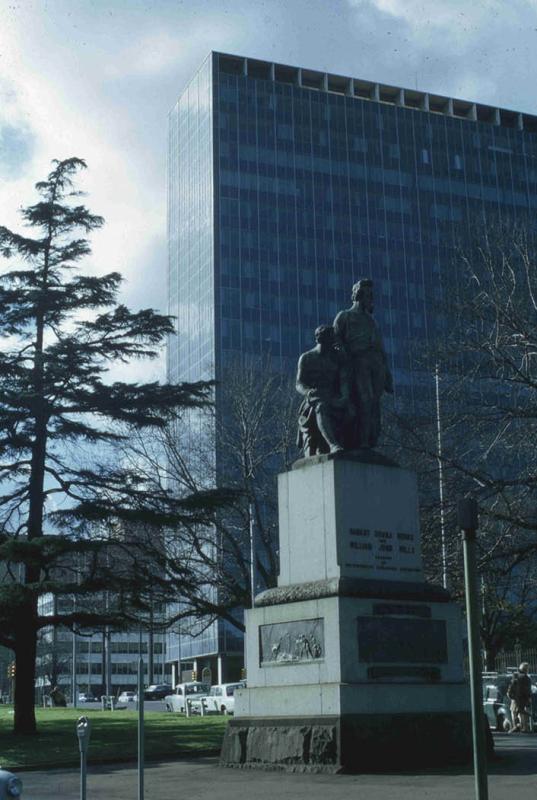Author:
Almost invisible
At the centre of this photograph featured in the Beyond Bluestone exhibition is a 19-storey office building that stands near the peak of Melbourne’s Eastern Hill. The 2018 exhibition put on display major public works which pushed the boundaries of Melbourne's architectural landscape, and no doubt you're wondering how an office block could have made the final cut. It’s not in the Melbourne Central Business District but in the adjoining suburb of East Melbourne and visible the whole length of Lonsdale Street as you look toward the east. You may have never taken notice of the building because the elements of its design are so commonplace they no longer seem radical or challenging, but they were at the time it was built.
The building is not particularly tall by today’s standards (around 81 metres high), but it was high enough to become the tallest building in Australia between 1958 and 1961 and started a trend that soon transformed the city and continues to do so. The building, ICI House, was named after the company that would use it for its headquarters, Imperial Chemical Industries of Australia and New Zealand Ltd. Construction was completed in 1958 and it became Australia’s first skyscraper and a bold embrace of modernism in the form of what was known architecturally as the International Style. Some elements of this style had already been used by the same architectural firm, Bates Smart and McCutcheon, in their 1952 design for the new Wilson Hall at the University of Melbourne, but this was a relatively low lying building not a high rise.
New heights and ratios
South Elevation and Cross Section, ICI House, Bates Smart & McCutcheon, VPRS 3183/P5, Unit 12, Item 55/3047
To get beyond the height limit in Melbourne of 132 feet (around 40.2 metres) that was set in 1916, the proposed tower would only use 41 % of the ground site, giving over space for a ground level garden, fountain and public sculpture. The developers negotiated an increase in height in exchange for the undeveloped ground space. To address the fears of the local fire brigade, new fire protection measures were introduced including a sprinkler system above the fifth floor upwards (the height that could be reached by fire brigade ladders). These measures succeeded in convincing government authorities to allow the building to reach higher – and this then set a new precedent that was soon followed.
In the photograph at the top of this post you can see a building above and slightly to the left nearing completion. This is the CRA Building (or Consolidated Zinc Building and Comalco House) which when it was completed in 1962 displaced ICI House as Melbourne’s tallest building (at 99 metres). This building is now gone, having been demolished to make way for the much taller 101 Collins St (50 storeys, 260 metres), which was one of a new generation of tall buildings that were built in the late 1980s and early 1990s.
Interior design and amenity
The interior design of ICI House was also revolutionary at the time. Gone were solid walls and barriers, the building was flooded with natural light that penetrated throughout its open plan floor space passing through transparent glass partitions that separated offices. Another innovative feature of the design was the confinement of the service core to the side of the building, which also contributed to the unencumbered open plan space of each floor, to maximise views to the exterior. The architectural firm further stamped itself on the interior of the building by designing its furniture.
In addition, the building had facilities that today are considered highly desirable in workplaces: a games room, cafeteria and rooftop promenade so that workers could find spaces to relax and also to work in less formal surrounds.
Revitalising and transforming the City
Part of the reasoning for allowing these kinds of buildings to be built in central Melbourne was a hope it would stimulate development and rejuvenate the city core, which had been in a steady decline as people moved further out into new suburbs on Melbourne’s ever-expanding fringes, seeking out more comfortable and mobile car-oriented lifestyles.
Ever since ICI House’s completion, Melbourne’s skyline has progressively grown taller and more jagged, using new construction techniques and adopting elements of the relatively unadorned International Style. Not all of them achieved the elegance of design of ICI house – for instance the Gas and Fuel towers that used to sit where Federation Square is now located were almost universally disliked and considered an eyesore marring a very prominent location.
In more recent times, the growing trend toward apartment living in inner city locations has led to a boom in residential towers, including Melbourne’s current tallest building Eureka Tower in Southbank. More recent apartment towers pushed Melbourne’s architectural boundaries by rising straight up from small plots without the kind of setbacks that were required of ICI House, causing concerns about street level liveability, loss of amenity, over-development, congestion and density. This led to a re-instatement of setbacks and other measures.
Material in the Public Record Office Victoria archival collection contains words and descriptions that reflect attitudes and government policies at different times which may be insensitive and upsetting
Aboriginal and Torres Strait Islander Peoples should be aware the collection and website may contain images, voices and names of deceased persons.
PROV provides advice to researchers wishing to access, publish or re-use records about Aboriginal Peoples



